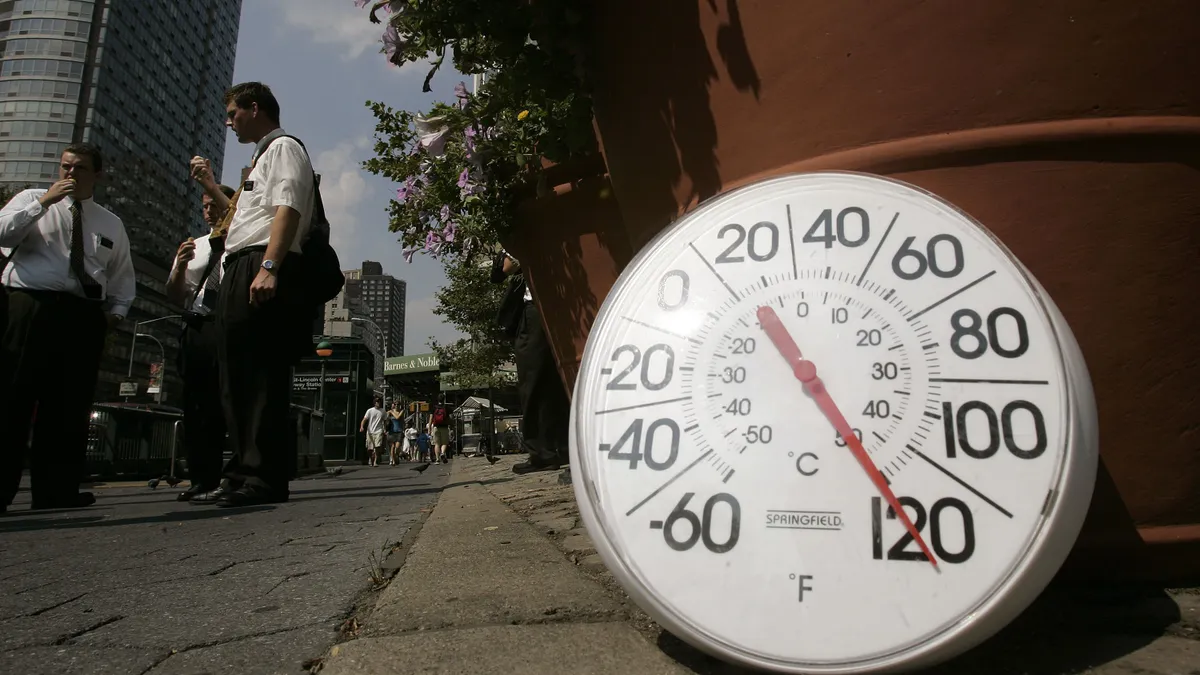Dive Brief:
- The White House announced yesterday that OSHA plans to create a federal standard to help prevent a growing and largely under-reported hazard on construction sites: heat-related illness.
- The advance notice of proposed rulemaking, set to be released next month, is the first step in the process for developing a workplace heat standard. It will initiate a comment period allowing OSHA to gather diverse perspectives and technical expertise on topics including heat stress thresholds, heat acclimatization planning, exposure monitoring and strategies to protect workers, according to a press release.
- Thousands of workers are sickened each year by workplace heat exposure. Despite widespread under-reporting, 43 workers died from heat illness in 2019, and at least 2,410 others suffered serious injuries and illnesses, according to OSHA.
Dive Insight:
Extreme heat kills more Americans than any other climate-related hazard, and workers’ rights groups and public health officials have long pushed for a federal worker safety rule, according to Politico.
Labor Secretary Marty Walsh said in the release that increasingly hot outdoor temperatures from climate change are adding to the issue.
"Amid changing climate, the growing frequency and intensity of extreme heat events is increasing the dangers workers face, especially for workers of color who disproportionately work in essential jobs in tough conditions," he said.
Even regions that are not known for heat waves saw problems with heat-related illness this summer. A construction worker in Oregon died of heat-related illness following a record-setting June heat wave in the Pacific Northwest that saw temperatures soar as high as 116°F.
Hot weather safety can be a challenge in traditionally cooler areas like the Pacific Northwest, Cameron Samuel, assistant safety director at Western Specialty Contractors, told Construction Dive.
"It is more difficult to protect workers in regions not used to extreme heat spikes, especially when they occur early in the summer season," he said. Especially early in the summer, crews are not used to the heat, which means their tolerance is low and they are more susceptible to heat illness.
Other steps
OSHA is also implementing an enforcement initiative on heat-related hazards and developing a National Emphasis Program on heat inspections. It is also forming a heat injury and illness work group to provide a better understanding of challenges and to identify and share best practices to protect workers.
OSHA implemented an intervention and enforcement initiative recently to prevent and protect workers from heat-related illnesses and deaths while they are working in hazardous hot environments. The newly established initiative prioritizes heat-related interventions and inspections of work activities on days when the heat index exceeds 80°F.
The OSHA initiative applies to indoor and outdoor worksites in general industry, construction, agriculture and maritime where potential heat-related hazards exist. On days when a recognized heat temperature can result in increased risks of heat-related illnesses, OSHA will increase enforcement efforts.
Employers are encouraged to implement intervention methods on heat priority days proactively, including regularly taking breaks for water, rest, shade, training workers on how to identify common symptoms of heat-related illness and what to do when a worker suspects such an illness is occurring, and taking periodic measurements to determine workers' heat exposure.
As part of this week's announcement, OSHA area directors across the nation will prioritize inspections of heat-related complaints and instruct inspectors to open an inspection when they observe employees performing strenuous work in hot conditions. They will also be advised to expand the scope of other inspections to address heat-related hazards where worksite conditions or other evidence indicates these hazards may be present.
The National Emphasis Program on heat hazard cases will target high-risk industries and focus agency resources and staff time on heat inspections. The 2022 National Emphasis Program will build on the existing Regional Emphasis Program for Heat Illnesses in OSHA's Region VI, which covers Arkansas, Louisiana, New Mexico, Oklahoma and Texas.
Many U.S. states run their own OSHA-approved State Plans and the following three states have their own standards for heat exposure:
- California. California's Heat Illness Prevention Standard requires employers to provide training, water, shade and planning. A temperature of 80°F triggers the requirements. See CalOSHA's website. See the full text of the California heat standard.
- Minnesota. The standard applies to indoor places of employment. See the full text of the regulation.
- Washington. See Washington State's Outdoor Heat Exposure Rule. See the full text of the regulation.














